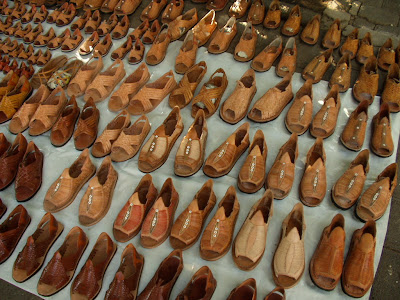Let's Get Lost
"We can drive to Atotonilco," I suggested, perusing my little guidebook. "We can take the Camino Viejo and the Route of Chapels..."
It looked pretty straightforward. Just head out of town on the main road in front of the main square and follow the signs...
Big Dog never trusts me or my judgement and made me ask the nice young man at the tourist office all the same.
"Is this where I make a right?" Big Dog asked me as we got out of town. "There's a sign pointing to Atotonilco..."
"I think that's the regular highway. The Old Road is the one up ahead, I'm sure," I answered. It was cobblestoned and certainly looked like The Old Road. The other road was just a regular asphalted highway.
"But didn't the guy at the tourist office tell us to make a right when we got out of town?"
I insisted we go straight. Big Dog did not share my confidence and so we asked several drivers and pedestrians along the way if this was the "camino viejo." "Yeah, sure," they all replied.
But the cobbled street soon became a rocky dirt road, and then a river crossing, and then no road at all. It was open countryside, with tracks in the pasture where wagons had been pulled. There were herds of cows and goats, a few horses, some cowboys on horseback, but no sign of anything suggesting a Ruta di Capillas, or Camino Viejo, or any chapel or church. Initially we followed the directions of the locals who pointed this way and that, until we finally realized: This was NOT El Camino Viejo for Atotonilco.
 Road to Nowhere
Road to Nowhere Another Road to Nowhere
Another Road to Nowhere"I guess I should have asked them if it was EL Camino Viejo," I said sheepishly. "I was probably asking them if this was AN old road and they were all thinking, 'Well, duh, of course this is an old road!'"
We rattled all the way back to where Big Dog wanted to turn, way back when. Back over the no-road road, across the river (again), over the rocks, dirt and finally cobblestone street. The actual Camino Viejo which looked deceptively modern near San Miguel de Allende also quickly deteriorated into a dirt road, but it did take us by a collection of rather unimpressive chapels and tiny, sominiferous pueblos to Atotonilco, home of the Sanctuario.
 A town along the Road to Somewhere...
A town along the Road to Somewhere... ...where we meet Rasta Dog.
...where we meet Rasta Dog."It's the Sistine Chapel of the Indigenos," enthused Mr. California. He had parked his big truck with a California license plate in front of us so we started chatting, finding out that he had exchanged his ranch in Atascadero, not too far from our ranch, for a place near this town.
Although the Sanctuario has interesting paintings on its walls, it really was no match for the real Sistine Chapel and in the end, Big Dog had to agree that the best part of the day was Getting Lost.
 Not really the Sistine Chapel...
Not really the Sistine Chapel... Was it all that driving along rocks? Or something more sinister? The next day, we discover our rental car has a flat tire.
Was it all that driving along rocks? Or something more sinister? The next day, we discover our rental car has a flat tire.Labels: Mexico, on-the-road, pics
























































